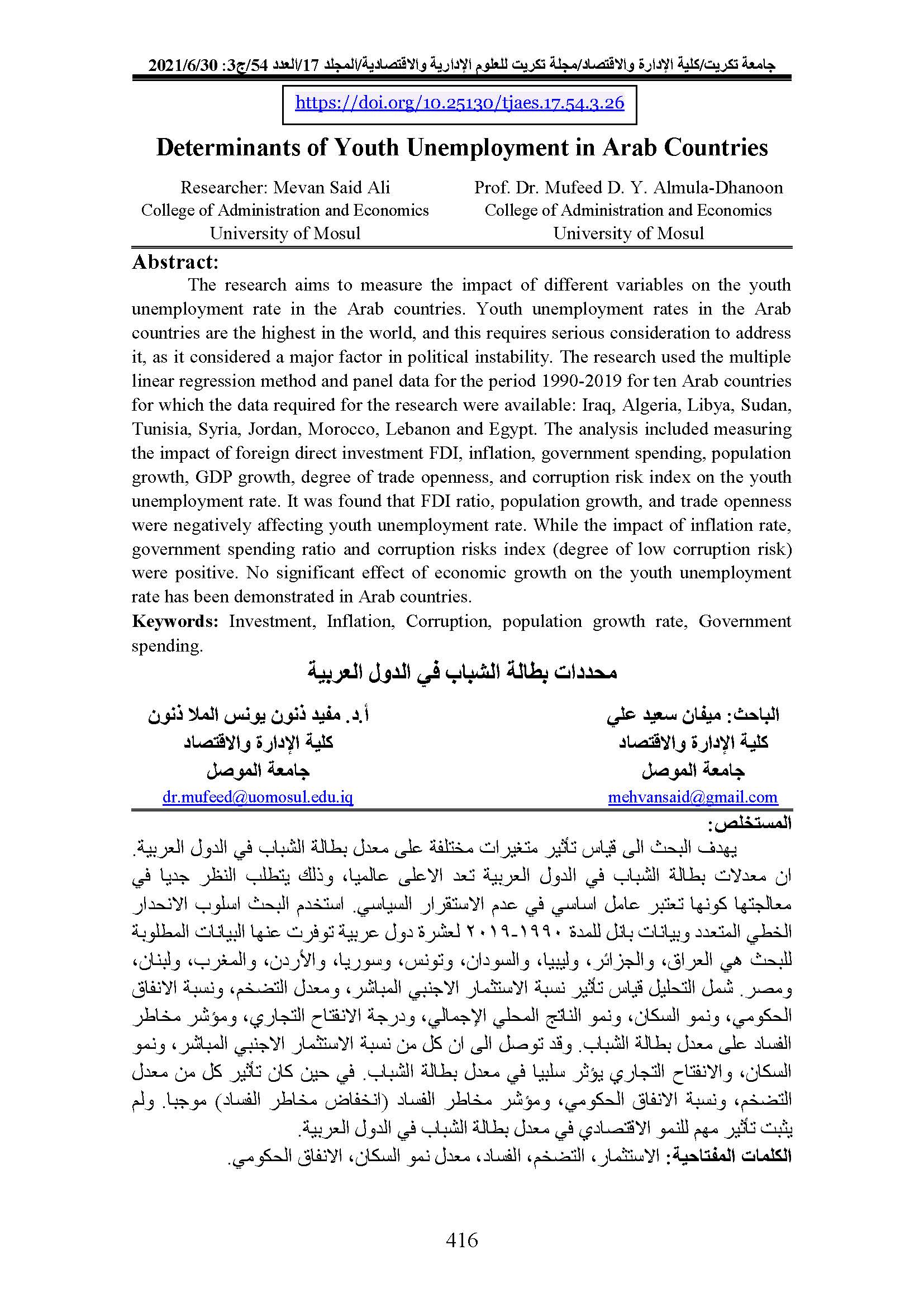Determinants of Youth Unemployment in Arab Countries
Main Article Content
Abstract
The research aims to measure the impact of different variables on the youth unemployment rate in the Arab countries. Youth unemployment rates in the Arab countries are the highest in the world, and this requires serious consideration to address it, as it considered a major factor in political instability. The research used the multiple linear regression method and panel data for the period 1990-2019 for ten Arab countries for which the data required for the research were available: Iraq, Algeria, Libya, Sudan, Tunisia, Syria, Jordan, Morocco, Lebanon and Egypt. The analysis included measuring the impact of foreign direct investment FDI, inflation, government spending, population growth, GDP growth, degree of trade openness, and corruption risk index on the youth unemployment rate. It was found that FDI ratio, population growth, and trade openness were negatively affecting youth unemployment rate. While the impact of inflation rate, government spending ratio and corruption risks index (degree of low corruption risk) were positive. No significant effect of economic growth on the youth unemployment rate has been demonstrated in Arab countries.
Downloads
Article Details
References
Alawin M., (2013), Trade Balance and Unemployment in Jordan, European Scientific Journal, vol.9, No.7, pp. 143-151:
https://citeseerx.ist.psu.edu/viewdoc/download?doi=10.1.1.975.5820&rep=rep1&type=pdf
Arslan M., and R. Zaman, (2014), Unemployment and Its Determinants: A Study of Pakistan Economy (1999-2010), Journal of Economics and Sustainable Development, Vol.5, No.13, pp. 20-24. https://core.ac.uk/download/pdf/234646459.pdf
Aurangzeb D., and K. Asif, (2013), Factors Effecting Unemployment: A Cross Country Analysis, International Journal of Academic Research in Business and Social Sciences, Vol. 3, No. 1, pp. 219-230. http://hrmars.com/admin/pics/1448.pdf
Behar A. and J. Mok, (2015), “Does Public Employment Reduce Unemployment?”, Topics in Middle Eastern and African Economies, Vol. 17, Issue 2, pp 110-121.
Bouzid B., (2016), Dynamic Relationship between Corruption and Youth Unemployment: Empirical Evidences from a System GMM Approach. Policy Research Working Paper; No. 7842. World Bank, Washington, DC, pp 1-23:
https://openknowledge.worldbank.org/handle/10986/25158
Chella, N. and Phiri, A. (2017), ‘Long-run cointegration between foreign direct investment, direct investment and unemployment in South Africa’, Munich Personal RePEc Archive, MPRA:
https://mpra.ub.uni-muenchen. de/82371/1/MPRA_paper_82371.pdf.
Chu T., et al, (2020), “The impact of productive and non-productive government expenditure on economic growth: an empirical analysis in high-income versus low- to middle-income economies”, Empirical Economics, 58, pp 2403-2430. https://link.springer.com/article/10.1007/s00181-018-1616-3
Dhamija N., (2019), Trade Liberalization and Unemployment in India: A State Level Analysis, MPRA, pp. 1-27. https://mpra.ub.uni-muenchen.de/95001/
Dutt P., et al, (2007), International Trade and Unemployment: Theory and Cross-National Evidence, pp. 1-32:
https://www.economics.uci.edu/files/docs/workingpapers/2007-08/ranjan-08.pdf
Eita J. and J. Ashipala, (2010), Determinants of Unemployment in Namibia, International Journal of Business and Management Vol. 5, No. 10, pp. 92-104:
https://www.researchgate.net/publication/46302799_Determinants_of_Unemployment_in_Namibia
Feldmann H., (2009), “Government Size and Unemployment: Evidence from Developing Countries”, The Journal of Developing Areas, Vol. 43, No. 1, pp. 315- 330.
Gaber H., (2018), Determinants of Unemployment: Empirical Evidence from Palestine, MPRA, pp.1-11. https://mpra.ub.uni-muenchen.de/89424/6/MPRA_paper_89424.pdf
Grahovac D. and Softić, S., (2017), ‘Impact of the FDI on Unemployment rate in countries of West Balkan’, Review of Innovation and Competitiveness: A Journal of Economic and Social Research, 3:2, pp. 65–82:
file:///C:/Users/Dell/Downloads/RIC_volume_3_issue_2_Dijana_Grahovac_Senad_Softic.pdf
International Country Risk Guide (ICRG) Researchers Dataset, (2019), https://dataverse.harvard.edu/dataset.xhtml?persistentId=doi:10.7910/DVN/4YHTPU
Kamran A., et al, (2014), A Study on Determinants of Unemployment in Pakistan, pp. 1337- 1348:
Liu L., (2008), Inflation and Unemployment: The Roles of Goods and Labor Markets Institutions, pp 1-29. http://qed.econ.queensu.ca/pub/students/phds/liuqian/JMP.pdf
Mahmood T. et al, (2014), Determents OF Unemployment in Pakistan: A Statistical Study, International Journal of Asian Social Science, Vol. 4, No. 12, pp. 1163-1175. https://www.researchgate.net/publication/268223948_Determinants_of_Unemployment_in_Pakistan_A_Statistical_Study
Meon P. & K. Sekkat, (2005), Does corruption grease or sand the wheels of growth? Public Choice (2005) 122: 69-97:
https://www.researchgate.net/publication/5154404_Does_Corruption_Grease_or_Sand_the_Wheels_of_Growth
Mirza M. et al, (2015), The Impact of Inflation on Unemployment to the Extent of Pakistan, Developing Country Studies, Vol.5, No.12, pp. 46-51.
Mohammed M., (2018), Some Determinants of Unemployment Rate in Sudan: An Empirical Investigation (1981-2014), A Dissertation Submitted to the University of Gezira in Partial Fulfillment of the Requirements for the Award of the Degree of Master of Science, pp. 1-37:
Onchari D., (2019), The Relationship Between Corruption and Unemployment Rates in Kenya, pp. 309-318. https://dergipark.org.tr/tr/download/article-file/712416
World Bank, (2019), World Development Indicators, Online Data.
Zeb, N., Qiang, F. and Sharif, M. S. (2014), ‘Foreign direct investment and unemployment reduction in Pakistan, International Journal of Economics and Research, Vol. 5, No. 2, pp. 10-17.


